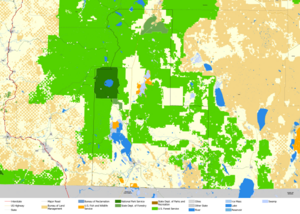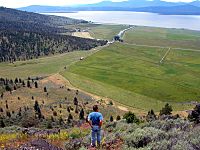Klamath County, Oregon facts for kids
Quick facts for kids
Klamath County
|
|
|---|---|
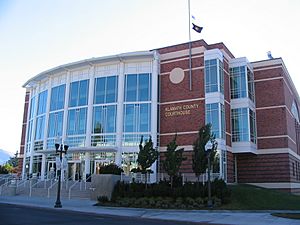
Klamath County Courthouse in Klamath Falls
|
|
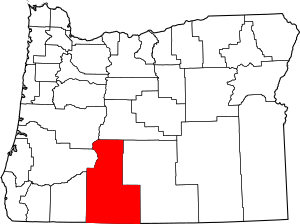
Location within the U.S. state of Oregon
|
|
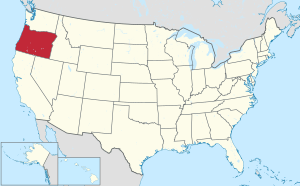 Oregon's location within the U.S. |
|
| Country | |
| State | |
| Founded | October 17, 1882 |
| Named for | Klamath Indians |
| Seat | Klamath Falls |
| Largest city | Klamath Falls |
| Area | |
| • Total | 6,136 sq mi (15,890 km2) |
| • Land | 5,941 sq mi (15,390 km2) |
| • Water | 194 sq mi (500 km2) 3.2%% |
| Population
(2020)
|
|
| • Total | 69,413 |
| • Estimate
(2023)
|
70,003 |
| • Density | 11/sq mi (4/km2) |
| Time zone | UTC−8 (Pacific) |
| • Summer (DST) | UTC−7 (PDT) |
| Congressional district | 2nd |
Klamath County (/ˈklæməθ/ KLAM-əth) is one of the 36 counties in the U.S. state of Oregon. As of the 2020 census, the population was 69,413. The county seat is Klamath Falls. The county was named for the Klamath, the tribe of Native Americans living in the area at the time the first European explorers entered the region. Klamath County comprises the Klamath Falls, OR Micropolitan Statistical Area.
Contents
History
The Klamath or Clamitte tribe of Indians, for which Klamath County was named, are the descendants of varying cultures of indigenous peoples, who have lived in the area for more than 10,000 years.
When European-Americans began to travel through the area in 1846 along the Applegate Trail, they competed with the Klamath for game and water, which precipitated clashes between the peoples. This was exacerbated by European-American settlers, who cleared the land to farm and encroached on hunting territory. They were successful in demanding the removal of American Indians to reservations.
The Modoc people, having been removed to Oregon to share a reservation with the Klamath, traditional rivals, wanted a reservation created on Lost River, near present-day Merrill, Oregon. Captain Jack led his band back to Lost River, but the US Army, accompanied by militia and citizens of Linkville (present-day Klamath Falls) arrived and convinced Captain Jack to return. An argument broke out, shots were fired, and the Modoc War began as the Modoc fled to Captain Jack's Stronghold in northern California.
A treaty was signed with the Klamath on October 14, 1864, which led to the establishment of the Klamath Reservation. At various times over the next 40 years, different individuals of the Modoc tribe were settled within the reservation.
Because of the extensive tracts of forest, the Klamath were very well off as a people until the termination of the reservation by the U.S. government in 1954. Termination parceled the communally managed land into individual sections, which tribe members could not manage on their own and were largely forced to sell to speculators.
A few of the Klamath refused to accept the buyout money, most notably Edison Chiloquin (1923–2003). Instead of cash, he insisted on receiving the title to ancestral land along the Sprague River where he lived. On December 5, 1980, the Chiloquin Act was signed into law, giving him title to the properties he wanted.
Geography
According to the United States Census Bureau, the county has a total area of 6,136 square miles (15,890 km2), of which 5,941 square miles (15,390 km2) is land and 194 square miles (500 km2), or 3.2%, is water. It is the fourth-largest county in Oregon.
Adjacent counties
- Douglas County (northwest)
- Lane County (northwest)
- Deschutes County (north)
- Lake County (east)
- Siskiyou County, California (south)
- Modoc County, California (south)
- Jackson County (west)
National protected areas
- Bear Valley National Wildlife Refuge
- Crater Lake National Park (part)
- Deschutes National Forest (part)
- Fremont National Forest (part)
- Klamath Marsh National Wildlife Refuge
- Lower Klamath National Wildlife Refuge (part)
- Rogue River – Siskiyou National Forest (part)
- Upper Klamath National Wildlife Refuge
- Winema National Forest (part)
Demographics
| Historical population | |||
|---|---|---|---|
| Census | Pop. | %± | |
| 1890 | 2,444 | — | |
| 1900 | 3,970 | 62.4% | |
| 1910 | 8,554 | 115.5% | |
| 1920 | 11,413 | 33.4% | |
| 1930 | 32,407 | 183.9% | |
| 1940 | 40,497 | 25.0% | |
| 1950 | 42,150 | 4.1% | |
| 1960 | 47,475 | 12.6% | |
| 1970 | 50,021 | 5.4% | |
| 1980 | 59,117 | 18.2% | |
| 1990 | 57,702 | −2.4% | |
| 2000 | 63,775 | 10.5% | |
| 2010 | 66,380 | 4.1% | |
| 2020 | 69,413 | 4.6% | |
| 2023 (est.) | 70,003 | 5.5% | |
| U.S. Decennial Census 1790–1960 1900–1990 1990–2000 2010–2020 |
|||
2010 census
As of the 2010 census, there were 66,380 people, 27,280 households, and 17,831 families living in the county. The population density was 11.2 inhabitants per square mile (4.3/km2). There were 32,774 housing units at an average density of 5.5 units per square mile (2.1 units/km2). The racial makeup of the county was 85.9% white, 4.1% American Indian, 0.9% Asian, 0.7% black or African American, 0.1% Pacific islander, 4.1% from other races, and 4.1% from two or more races. Those of Hispanic or Latino origin made up 10.4% of the population. In terms of ancestry, 20.0% were German, 14.7% were Irish, 11.9% were English, and 5.5% were American.
Of the 27,280 households, 28.4% had children under the age of 18 living with them, 49.7% were married couples living together, 10.7% had a female householder with no husband present, 34.6% were non-families, and 27.3% of all households were made up of individuals. The average household size was 2.40 and the average family size was 2.88. The median age was 41.7 years.
The median income for a household in the county was $41,818 and the median income for a family was $51,596. Males had a median income of $42,215 versus $30,413 for females. The per capita income for the county was $22,081. About 12.7% of families and 16.6% of the population were below the poverty line, including 21.8% of those under age 18 and 9.1% of those age 65 or over.
Communities
Cities
- Bonanza
- Chiloquin
- Klamath Falls (county seat)
- Malin
- Merrill
Census-designated places
- Altamont
- Beatty
- Beaver Marsh
- Bly
- Chemult
- Crescent
- Crescent Lake
- Falcon Heights
- Fort Klamath
- Gilchrist
- Keno
- Oregon Shores
- Rocky Point
- Running Y Ranch
- Sprague River
Other unincorporated communities
- Ady
- Algoma
- Cascade Summit
- Dairy
- Fairhaven
- Hager
- Hatfield (part)
- Haynesville
- Henley
- Hildebrand
- Hot Springs
- Kirk
- Klamath Agency
- Lake of the Woods
- Langell Valley
- Lenz
- Lorella
- Malone
- Midland
- Modoc Point
- Odell Lake
- Odessa
- Olene
- Pelican City
- Pine Grove
- Pine Ridge
- Shevlin
- Worden
- Yonna
Economy
Historically, Klamath County's economy was based on timber and agriculture, and although these natural resource industries now contribute only a small fraction to the region's current economic activity and employment, their legacy lives on in local politics, community identity, and landscape. Euro-American settlement in the area was spurred in the early 20th century with the coming of the railroad. In addition, the government-subsidized federal reclamation project, the Klamath Irrigation Project, dammed upper tributaries and drained much of the 128 square miles (331.5 km2) Lower Klamath and Tule lakes to convert 188,000 acres (760 km2) of former lakebed and wetlands into farmland, to be supported by irrigation.
Today the Sky Lakes Medical Center is the largest employer in the area, followed by Klamath County School District and Jeld-Wen, a manufacturer of doors and windows. The area is currently experiencing a boom in housing construction, as its proximity to California brings waves of retirees from population centers to the south. Outdoor recreation, such as hiking, hunting, and world-class trout fishing, as well as Oregon's only National Park at Crater Lake, contribute to the economy of the area. A complex of six National Wildlife Refuges—Klamath Basin National Wildlife Refuges Complex—seasonally draw some of the largest concentrations of waterfowl in North America. The area is world-renowned as a birdwatcher's paradise. Natural geothermal hot wells provide heat for many homes, businesses, and the Oregon Institute of Technology campus. The full potential of this energy resource continues to be studied.
Education
Colleges and universities
- Klamath Community College
- Oregon Institute of Technology
See also
 In Spanish: Condado de Klamath para niños
In Spanish: Condado de Klamath para niños


